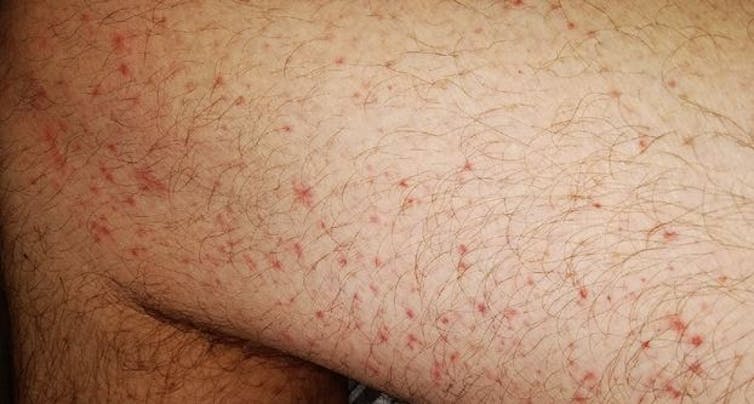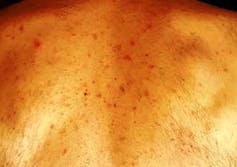Michael Freeman, Bond University
As the pandemic progresses, we’re growing increasingly aware COVID-19 affects multiple parts of the body beyond the lungs. That includes the skin.
We’ve seen reports of skin symptoms ranging from ‘COVID toes’ to hair loss, and different types of rashes.
Some skin symptoms appear soon after infection, while others arise later or in more severe disease. Most get better with time.
Researchers are also beginning to work out what causes these skin conditions, whether it’s the body’s immune response to infection, or whether hormones are involved.
Here are some of these symptoms, from the most common to the least:
1. widespread small red bumps and multiple flat red patches. These so-called maculopapular eruptions are associated with more severe disease

2. redness of the whites of the eyes. This conjunctivitis is most common later in the disease and in more severe disease
3. chilblain-like symptoms, commonly called ‘COVID toes’. These can affect hands or feet, or both at the same time. The red-purple discoloured skin can be painful and itchy, and there are sometimes small blisters or pustules. These chilblain-like lesions often appear late in the disease, after other symptoms, and are most common in children
4. hives or urticaria are pink or red itchy rashes that may appear as blotches or raised red lumps (wheals). They range from the size of a pinhead to a dinner plate. Swellings usually disappear within minutes to hours in one spot, but may come and go. Mostly hives clear within ten days. They occur at the same time as other symptoms, in all ages, and are associated with more severe disease

These water blisters, or vesicular eruptions, are more common in middle-aged people with COVID-19. British Journal of Dermatology
5. water blisters, or vesicular eruptions, are small fluid-filled micro-blisters that may appear early in the disease or at any time, often on the hands. Middle-aged patients suffer more commonly. The blisters last just over 10 days, and are associated with medium-severity disease
6. ‘fishing net-like’ red-blue pattern on the skin, or livedo, sometimes with tiny bruises (purpura), is associated with more severe disease and older age groups. This pattern is thought to be due to blockages of the blood vessels that arise as part of the body’s immune response to the virus
7. rash associated with multisystem inflammatory syndrome in children or MIS-C. This “immune system overdrive” triggers an inflammation of the heart and blood vessels, resulting in blood clots and symptoms of shock. This very rare complication can occur up to three months after a child has had COVID-19
8. hair loss (telogen effluvium) occurs in many severe illnesses, including COVID-19. This is the body shutting down unnecessary activity in times of stress. Provided people’s iron levels are normal, the hair will recover in time
COVID-19 serious enough to take people to hospital also seems to be more common in people with male-pattern baldness. One study found up to 79 per cent of hospital admissions for COVID-19 were balding men.
An increased level of the hormone dihydrotestosterone is thought to increase the numbers of ACE2 receptors, which is how the virus enters the body. In other words, male-pattern baldness may predispose people to more severe disease.
What could be causing these symptoms?
Some of the COVID-19 rashes are not caused by the virus itself, but by the body’s immune response to the virus.
For instance, research suggests some may be caused by over-activation of a part of the immune system known as the “complement” response. This leads to the blood vessel damage seen in the chilblain-type symptoms (point 3 above) and in livedo (point 6).
Complement activity is also increased in elderly people and may well explain many of the more serious COVID-19 outcomes we see in this age group.
How do I know if my skin rash is COVID-19?
If you’re concerned about any skin symptoms, check them against the photos in this article. Then you can consult your GP or dermatologist via a telehealth appointment for further advice.
You might be infectious. Get tested and self-isolate until you receive your test results. If you feel unwell, your GP or COVID clinic will be able to coordinate your care.
Michael Freeman, Dermatologist, Associate Professor, Bond University
This article is republished from The Conversation under a Creative Commons licence. Read the original article.
Are you surprised by the ways COVID-19 can affect your skin and hair? Do you think the general public is taking the pandemic seriously enough, or do you think people are overreacting?
If you enjoy our content, don’t keep it to yourself. Share our free eNews with your friends and encourage them to sign up.
Related articles:
https://www.yourlifechoices.com.au/health/covid19/life-after-covid-a-myth-experts
https://www.yourlifechoices.com.au/health/covid19/410-species-at-risk-of-covid19
https://www.yourlifechoices.com.au/health/wellbeing/the-search-for-love-in-lockdown

